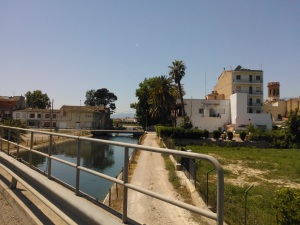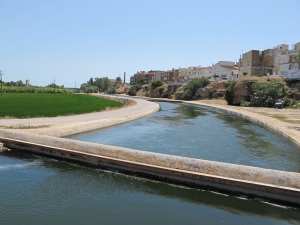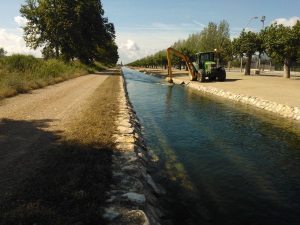This name encompasses the two major infrastructures that carry water from the Ebro to the delta area, from the Assut de Xerta to the rice crops. All this infrastructure, which starts from two large canals, the one on the right and the one on the left, is divided along its route until it becomes the small ditches that supply water to each of the rice fields. This system does not work all year round, and remains dry at the beginning of the year. When this system starts up in the spring surroundings, little by little it is colonized by different macrophytes, among them Potamogeton pectinatus, and with them, the black fly larvae that find in this system an ideal habitat for their development. The periodic cleaning tasks carried out by the irrigation communities minimize the presence of these larvae, but in those sections in which access by the cleaning machinery is not possible, as they pass through the different populations (Jesús, Roquetes, Amposta), black fly larvae continue to develop, thus increasing the problems caused by this insect's bites in these populations.

In the smallest pipelines a control is also carried out, especially in those that are closer to urbanized areas.

Sampling: the sampling of the channels varies depending on the size of the infrastructure sampled. Thus, the largest channels, with little accessibility to the walls of these and with a considerable current, are sampled with the help of a hook with a handle that allows to reach the macrophytes adhered to the walls of these and capture a sample to observe if larvae are present or not.

In the smaller channels, where the flow is considerably lower and shallow, we can find the larvae adhering directly to the bottom, as in a garden irrigation ditch, or adhering to the macrophytes that develop on the bottom. In these cases, the sampling is carried out by capturing a sample of these macrophytes and making a count of the larvae present, if not found, a bottom brushing is carried out with the help of a brush and a 500-micron mesh screen with which the larvae are collected. The sediment that is collected with the mesh is placed in a basin with water and the larvae that have been collected are counted.
Control: the control of the canals at the Jesús and Amposta points is carried out manually by directly applying the necessary Bti product upstream of the inhabited nuclei for approximately ten minutes. This control is the closest to the one carried out in the river, but in this case the flow is 30 m3/s.
In the smallest pipelines this treatment is carried out manually by applying Bti with the help of a backpack where the product is mixed with the necessary water to obtain an adequate concentration of product and a volume of the mixture that allows us to apply the product for a specified time.



